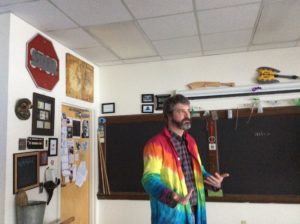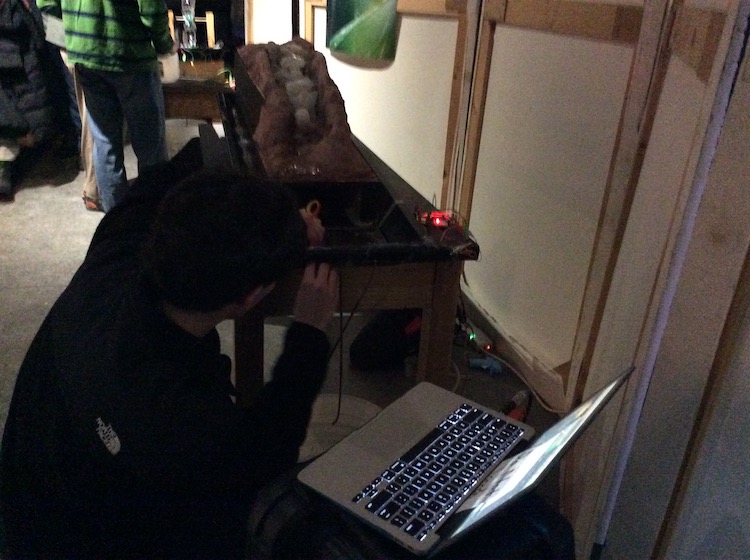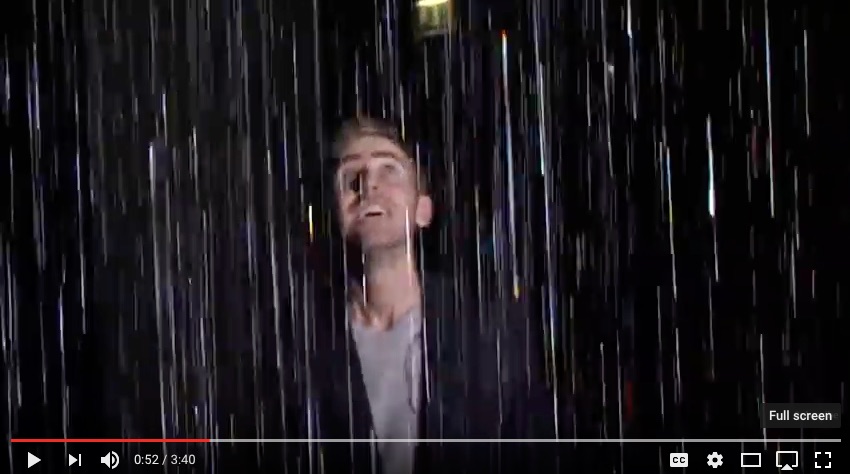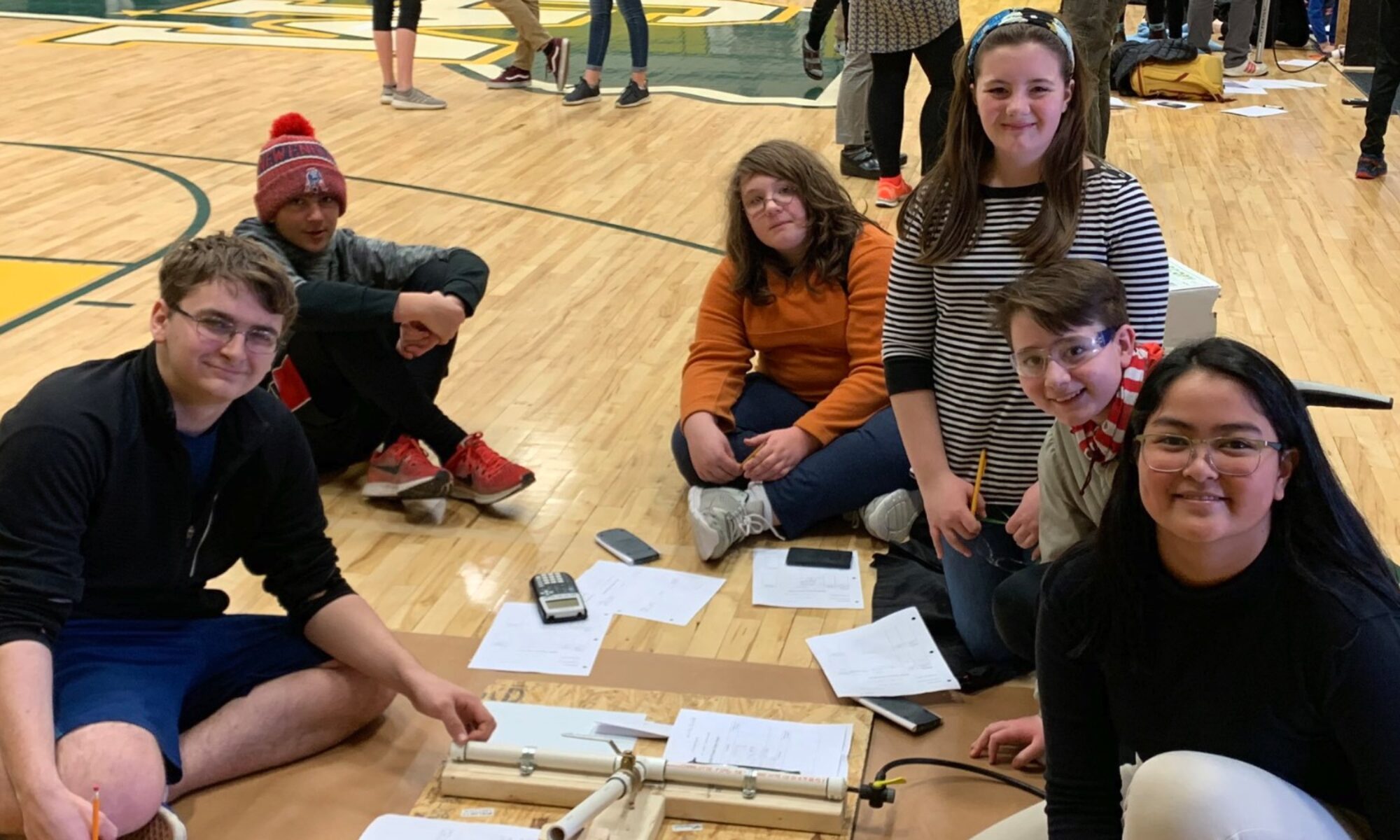Wondering how to blend project-based learning with STEAM?

Yes, STEAM: Science, Technology, Engineering, Arts and Math. Earlier this year we profiled The Cabot School’s amazing public exhibition of sound sculptures highlighting water conservation. They were a big hit with the Cabot community, the students who made them and, it turns out, a fair number of you guys, too: our readers.
In this episode of The 21st Century Classroom, we talk with Cabot School educator Michael Hendrix. We hear about what it takes to pull off STEAM-powered PBL and why Hendrix feels you can’t ever really teach science without art.
A full transcript appears below.

Michael Hendrix: We never use overhead lights. It kind of just… kids feel like it sort of sucks the soul out of the room. It’s sort of a gross feeling when you’re sitting under fluorescence, and so the stuff that we light the room with are these LEDs that we use with the AP Environmental Science class from two years ago when we did a project called Lillian, where we built a sustainable art and lighting sculptor piece to go with this folk opera that we were covering. We lit the room with all this alternative lighting and the kids won’t let me turn off the lights or won’t let me turn them on rather. So on darker days in the winter, this place is sort of like a pulsing, living thing. Yeah, it’s usually a pretty active place hence the mess.
Meet Michael Hendrix.
Hendrix: My name is Michael Hendrix. I’m a fifth-year teacher. This is my fourth year at Cabot School. I teach Earth Science, Physics, Biology, AP Biology, Chemistry, AP Environmental Science, Maker Science this year, last year Statistics and Probability. I taught a senior experiential lab. I may be leaving something out.
What he’s leaving out is that he tasked his current students with building Makey Makey-powered sound sculptures that helped raise awareness of water conservation and crisis. You might’ve heard about them on a previous episode of our podcast.
Students shared their sound sculptures with the Cabot community at a public exhibition, pairing their interactive art pieces with TED Talks on the water crisis. The community loved it.
We did too. So we set about asking Hendrix how he, as an educator, pulled this off with his students.
Hendrix: What students did is, we looked at the ideas behind fresh water and the water crisis, and all of the things that are happening with the world around preservation of water, and where are we going with the future of water, and in the process I knew my students needed to be doing some circuity and some basic programing. Also, learning how to build interfaces and sort of unpack basic programing.
So I came to them with the idea of, “Hey, let’s build an interactive art exhibit. It has to center around this idea of water, but in the process, let’s talk about what the things that you’re most interested in, in water.” So we looked at art. We looked at different installations of art just to help generate ideas; different water sculptures that other people had created in different contexts and different museums, to help to sort of prime them and get their brains going.
We also studied ambient music for a while too.
Wait. What does ambient music have to do with science?
Hendrix: So we were listening to Brian Eno’s early albums. Students were doing reviews on this music. We had a jam session with just our computers in here one day where we all tried to, without talking, communicate a certain sound or an idea, based on what that other person’s first note was that they played on their computer.
So we opened up GarageBand and had music typing up where we could play sort of a keyboard by using like ASDF, JKL. Students unpacked that and found out what sounds were dissonant and what sounds worked well together. One of the main ideas we wanted to reinforce in the sound sculpture collage was that all of the pieces had noises that were unique, sounds that were unique, tones that were unique, but at the same time didn’t overwhelm the listener or cause a lot of dissonance between sculptures. They had to exist with each other, but also remain sort of independent. So we played around with some basic circuity.
Once they’d been working with sound for a while, Hendrix amped up the circuitry side of things with Makey Makeys, very small and simple electronic microcontrollers.
Hendrix: The Makey Makeys that you can get for 50 bucks online, I picked up a few of those with a grant last year and we had some from our library that we’re using with the maker space in there. The students began to play games with the Makey Makeys and just figure it out a little bit. We had like three or four days where they just played with Makey Makey.
What we did is we wired those into the computer and substituted sounds on Garageband for each one of those connections that were made through the Makey Makey. They learned how to strategize circuitry. They learned how resisters worked. They learned how… a little bit of voltage. A little bit about electrical currents. They had to build all of that into their sculpture. There had to be an interactive piece or some kind of piece that ran itself. It had to be generative too. One of our students, James, had a life-size… or a scale model rather, of Sperry Glacier out in the west and as that thing melts, it slowly erodes the landscape and generates its own tones as the water, and the land, and the silt, and the clay sort of wash off.
As the thing deconstructs, it creates something new and then when it’s all over, when the glacier’s gone, the music stops.

After playing around with sound and circuits, the students set about doing their research.
Hendrix: The students all investigated different ideas that they were interested in with regards to water. We talked about war. There was a student who was very interested in the mechanical aspect of water wheels. So he wanted to sculpt one of those. So we talked about how to make that a little bit more scientific. How do we build this into something that’s not a crafts project? How do you make it more scientific?
Hendrix: I had design constraints that I put them under that I met them with, and then they worked within that framework. Water is a big idea and it’s not easy for somebody to just attach themselves to that and say, “Hey, listen. Water is really important. I love this aspect of water.” People don’t usually think about water that way. The way that we began to sort of inspire those ideas, was to look at what other people had done with water. What are the facts about water? What is it like in our community? Why is water important to us if we’ve got Lake Champlain over there? Are we going to be affected by the water crisis? So it’s really about exploration. Bringing the science back to the content and then also meeting the standards of learning to do circuity and also deconstructing and recreating things.
Many of the non-circuitry materials in the sculptures came from an old piano that the town of Cabot wanted to get rid of. Hendrix and his students were only too happy to oblige, using a method he calls “Break It / Build It”.
Hendrix: We got a call from the town and they said, “Hey, listen. We know you’re teaching the maker’s class this year. We’ve got this really busted up piano upstairs that (a) is insanely heavy and (b) we don’t want to service anymore because it’s really going to cost more to even fix this thing than it is to just chuck it.” So they called me and I said, “Hey guys. Do you want to go spend a couple of lab days shredding a piano and deconstructing it?” Of course, they’re always like, “Yeah, let’s go get the sledge hammers.” The real lesson there was, let’s deconstruct this. Not destroy it. Let’s deconstruct it, right. There was some brute force that was used, but there was also a tremendous amount of meticulous time-consuming deconstruction that I think the kids now have a much deeper appreciation for what actually went into that thing.
I can’t tell you how many times, as we were cracking it open, they were like, “I had no idea so much stuff could fit in this tiny space.” We talked a little bit about the history of the piano. I mean, you have to think, this has been hundreds, and hundreds and hundreds of years of improvement on this one design. I mean, this is the perfect lesson for makers, right. Like this is the epiphany of efficiency, this thing. Apart from having to moving it, everything is really compact. There’s a harp in there and there’s all of these strings and the way that they’re strung; has all been done with a particular design. Yeah, we’re going to have a lot of fun tearing this thing apart, but we’re also going to be able to figure out how this thing works.
As we started taking them apart and we saw all these metal pieces, we kind of as a group just said, “Hey, wouldn’t it be cool if we started putting these back into the Flow Project?” It made so much sense, because we were talking about water in the Flow Project, and we’re making these musical instruments and musical sculptures. Why don’t we transform this musical instrument and turn it into something completely new?
When students sat down to design their sculptures, Hendrix gave them a lot of freedom in the design process.
Hendrix: I made recommendations, but I let them do their own thing. I think the design constraints that we put around the sculptures helped them to sort of shape their ideas. They knew that this needed to be a cohesive exhibit, right? They all had to have a level of genuineness that was — the kids were all heavily invested in their designs. One thing that they did really well was, they took the things that meant something to them and then created a piece of art, pitched it to the group and then we kind of tuned it a little bit that way. I think as they were designing it, they were keeping in mind that this needed to be not just a one-off piece that existed on its own.

They knew that they were going to be working with other people on it and so they were very mindful about collaboration of this. One thing that we do really well at Cabot is collaboration. So they’ve had some practice with working in groups and individualizing things for themselves.
Throughout the whole unit, Hendrix and the students continued to study art.
Hendrix: I think looking at the art exhibits that we looked at, studying the art for the week or two prior to launching the project, really helped them shape their ideas about what makes art a functional thing, and when does art not work, and when does art work really well.
What’s the message of your artwork going to be? What is the message that… first off, what is the message that you want people to get from your artwork, and in its current state, and what is the message that it’s actually giving to people? Because the difference between good art and bad art is the level of communication that’s there, right. It’s the level of misunderstanding or the level of understanding. We talked about the nature of art for quite a bit and the philosophy behind why it is that we’re creating these things. It wasn’t just about rain. It wasn’t just about water. It wasn’t just about trying not to keep your sink running when you’re brushing your teeth. It was a bigger picture. It was a bigger idea. We fit it within the interest of those students too.
The pieces they always gravitated towards were always the ones they were like, “Oh… the guy walking into the rainstorm. That’s pretty awesome. How did he do that?”

Hendrix: Well, how do you think he did it? What’s making this work? What could possible allow this to work? Is this art? It’s raining indoors. This looks like water falling from the sky. What are they trying to get you to ask yourself when you’re walking through this? We wanted to extend it beyond just self-expression or just doing something cool. We wanted it to be conversational and want to have people use the art to learn about it.
From the beginning, the sculptures were intended to be presented to the Cabot community.
Hendrix: We felt that the nature of the presentation, of the TED Event, provided the information. The TED Event, the speakers at the TED Event provided the information. Then we felt like visually and interactively, we also wanted people to experience it. We thought that it was a nice dovetail between the two ideas, what was happening in makers class and TED, to sort of capitalize on those ideas that were presented, in a professional manner in the larger room, in giving them many skills that are associated with just that public presentation, that high-stakes exhibition; but also allow people to come in and play. So much of science is about play and controlled play.
And the community loved them.
Hendrix: Oh yeah. The whole event… we were getting emails right after we left. It was really sweet. I was checking emails on the way home and we had had like two or three emails from parents immediately and community members immediately. The big thing is how the kids reacted to it. The kids were just over the roof, over the moon. They loved it, but up until that exhibit, those last two days. I mean, they were really up to the wire and getting stuff done, but they executed it. They were under real working conditions in terms of you’ve got a deadline just like a professional does and your reputation is on the line. If you can’t demonstrate that you learned something about this and create something that’s functional and unique.
Still, there were definitely challenges along the way, especially as the date for the exhibition loomed closer, and closer.
Hendrix: For me, the rubber really met the road towards the end. That last week was a really tough time. It was mainly because tensions were high. Students knew that this was an encroaching deadline. We were having snow days and stresses were really high. Students were really feeling very anxious about it. That they would be able to use the abilities that they had to be able to execute it in that time. I always knew that they had it, but crankiness and things like that started creeping in at the very end. So it’s important to, when students have a really difficult time, or get cranky or are really feeling stressed, to sort of reemphasize the human component. Like, “Okay, come on, come on. Come on guys. Come together. Let’s talk for a minute. Let’s laugh. Let’s look at some stuff. Let’s look at some art. Let’s decompress for a minute. Reunite with your sense of play. You can’t think about this as work. You have to think about this as play.”
Hendrix does have advice for any educators looking to try this project with their students.
Hendrix: The best way to start this project, I think, is to firstly learn the material yourself. So play with the Makey Makey. You need to have the mechanics down. You need to understand the circuitry. Practice the circuitry. Try to do something kind of cool yourself, first. One of the things that I did to launch this project was I built a burette machine that drops drops of water across wires. I ran it into my computer and I made a generative music device. I brought it in and I showed the kids. They were kind of like, “Wow, we can do that with that little circuit board?” I said, “Yeah, man. All you have to do is just; you just put a couple of wires in there. You ground it to the earth. You know, you complete the circuit. It’s a lot easier than you think it is.”
What other advice would I give? Build a curriculum that’s flexible enough to account for student interest, without accounting for just your interest. Let them design it, not you. So, don’t say, “Hey, you know what you should do? You should build a water wheel.” If you’ve got a kid that’s really interested in building a water wheel, challenge the kid and say, “Hey, listen. How are we going to make this more scientific and not just an arts and crafts project? What is that water wheel going to do? What’s the interactive piece to this? Just pouring water onto a tray isn’t going to do it for the audience. You’re going to need to have some element there that’s going to show them in real time that what they are doing to the environment and to that particular sculpture is actually having an effect.” Yeah, we try to live by the philosophy of do the project first yourself.
And some advice for students, too.
Hendrix: Create something meaningful for the audience, but also create something that’s meaningful for you. There will be frustration, but the frustration can easily be overcome by experimenting, using the scientific method, trying new things, figuring out which wires go where. If they didn’t work, why they didn’t work. There’s a reason for everything. In a lot of ways, it’s sort of the same advice that I would give to educators too. You’ve got to embrace the chaos, but you have to have a goal in mind that you want to reach.
“We never know the worth of #water until the well is dry.” – Thomas Fuller pic.twitter.com/8TGYmR9007
— Cabot Science (@CabotScience) January 27, 2017
Hendrix strongly believes any type of student can build circuitry-based sculptures, and that all students can do both art and science. It’s part of fighting back against a mindset that would confine the two disciplines to separate areas rather than recognizing that they’re all part of the same bigger story.
Hendrix: So if a student is classically good at science, but doesn’t like to be considered an artist or thinks that they are terrible at art, well it’s sort of a self-fulfilling prophecy. If you think you suck at art, you’re not going to practice art, and so you will suck at art; but if you practice these things and you try these new things, then you’re opening yourself up to appreciating the universe in a different way. It’s all about connectedness in my mind. I’m not interested in boring science project. I’m interested in stuff that’s going to get me going and if I’m going, the kids are get going. When the kids are going, I’m going and so yeah. It’s all about the connections. It’s not just about science versus art or… I think that’s all fallacy.
Audrey: How would you have approached getting a student’s enthusiasm for this project up if they thought that they were only an artiste, but found the science really intimidating?
Hendrix: Oh, we had a really good conversation about that. We talked about… so we spent like a better portion of one of the days, back when we were talking about the philosophy of art and we were talking about the philosophy of creation, and executing successful works. We talked a lot about like the ego that’s associated with art and are you really an artist all the time or are you an artist for a moment, and you’re a sculpture or you’re a creator all the time. We talked about how it’s dangerous to put labels on things like saying I’m an artist, I’m a Democrat, I’m a Republican, I’m a scientist. Like I said before, you’re a human being and so you have to unpack the ego from the art.
I mean, do yourself some credit. You’re bigger than that, you’re better than that. You may be really, really good at this one thing, but that’s because you practice it all the time. You might be really awesome at this other thing and you might have a whole new appreciation for the issue if you try it from a different perspective. Then they start using it. I think they get it. They seem to get it, but you have to convince them by letting them do it. It’s not enough for me just to preach to them. I say, “All right. Well, build it. Find out. What about this thing do you think is artistic? What are the elements of this that are artistic?” We’re not going to say that this is a successful artwork, but what parts of this do you feel approach art?”
I think that’s all over the universe. The way that a drawer is designed, I think has elements of really beautiful artistic engineering. We don’t tend to see that. We tend to see the object that we need to use.
Audrey: What’s the one thing you hope your students took away from this project?
Hendrix: Confidence. An appreciation for… I would say confidence and I would say an appreciation for the non-mutually exclusive relationship of art and science. There’re two sides to the same coin, and I think if we start teaching our kids that there is no use for arts, or we slash funding to the arts, but we keep the sciences, I don’t think that’s right or fair. I don’t think it’s fair and I don’t think that’s reality. You need to be able to approach your world, your understanding, your reality from as many different perspectives as possible. From the conservative side, and the liberal side and from every side and that includes the arts and the sciences. I would hope that they, in this project, learned about unity and that art and science are not mutually exclusive disciplines.


